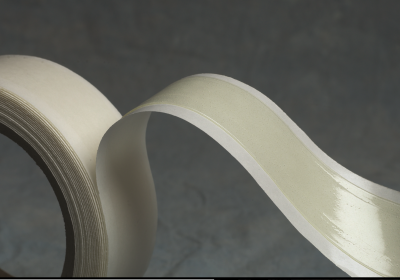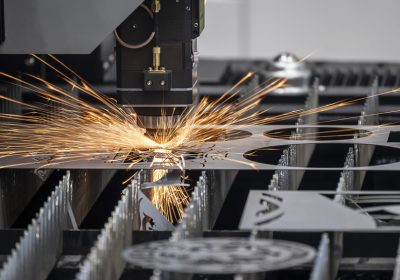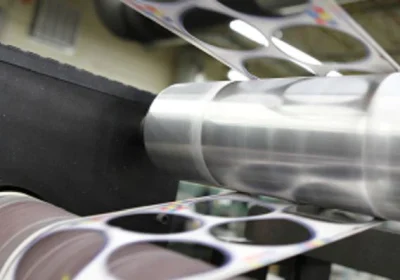Many flexible material converters become partners with manufacturers in the automotive industry, a highly competitive environment where precision is necessary. The vehicle building process can be compared to die cut adhesives.
Stick with me for a moment.
Building a car isn’t as simple as purchasing a block of steel and shaping, cutting, and grinding it into a vehicle.
Instead of labor-intensive processes, the manufacturer will purchase a chassis to add pieces all made separately. Its assembled components are similar to die cut adhesives. Instead of hand-cutting parts or laminating multiple layers, the crucial pieces arrive prepped and ready to go.

A Quick Overview of Die Cut Adhesives
Die cut adhesives create physical bonds — permanent or temporary — between components, yet these are regularly converted into custom sizes, shapes, and formats to make assembly processes easy.
You likely understand how a roll of pressure sensitive adhesive tape works. While “master rolls” are large, heavy, and not convenient to use in most manufacturing processes, when they’re slit properly, rolls of tape are inexpensive and familiar.
Die cut adhesives create tight, clean, low-profile connections and expand or contract as temperatures change. One decisive advantage of die cut adhesives is their ability to bond a wide range of items (see #5 below). Plus, you might be surprised by their versatility and the surprising applications of die cut adhesives.
Reasons Why Die Cut Adhesives Beat Rolls of Tape
1. COST
Let’s talk about why rolls of tape are selected over die cut adhesives: they cost less. When materials are the same, a die cut piece will always be more expensive due to production costs. However, you shouldn’t only look at the material cost when you must consider the total cost.
If the adhesive needs to be a specific shape or size for the application, you’re concerned about the speed of your process, or if your labor costs are climbing, consider die cut production.
2. PRODUCTION
Production managers often view daily or hourly throughput as a baseline for productivity.
Unfortunately, it’s also likely to keep them up at night.
Handling and dispensing rolls of tape is more complicated than it seems. While some applications are straightforward and smooth, the majority have corners, odd sizes, or cut outs, which slow down production speeds and increase the chances of error.
Die cut material provides better support to assembly operations because it doesn’t require special equipment. Plus, production is a lot faster using die cuts and far more accurate than someone cutting strips of roll tape by hand.
3. ACCURACY
Cutting rolls of tape by hand can’t come close to the accuracy of a die cut piece, which is perfect every time.
The difference in placing these two options is significant: one is an exact fit that’s easy to handle, and the other is a flimsy material that needs to be measured and cut every time.
Your workforce will not only perform better, but they’ll also feel less stress and pressure.
4. LABOR
Applying both die cut pieces and tape from rolls often requires people power. Unfortunately, helping your operators complete an application isn’t always at the top of your mind.
Tabbing is an excellent example of adjusting for ease of production.
Adding tabs to a die cut piece (something not possible with rolls of tape) makes using them more accessible and allows production to start and stop quickly. Apply a die cut piece, handle the product as needed, then use the tab to remove the liner and expose the adhesive.
Rolls of tape are more challenging to apply, and getting the liner off can be time-consuming.
5. DISSIMILAR SUBSTRATES
Unless both surfaces have the same surface energy, a roll of tape, such as a double sided or a transfer tape with the same material on both sides, won’t help bond two different substrates save for expensive differential adhesives.
A custom die cut can bond dissimilar substrates using differential adhesives. Differential adhesives allow you to bond two different materials more cost-effectively.
6. LESS WASTE
Waste is never a good thing, and a die cut piece trimmed to an exact shape has no overlap and less wasted material.
Covering a large area using a roll of tape is labor-intensive and requires overlapping tape strips to create reliable masking. That wasted material adds up quickly and drives up a carbon footprint.
In addition, consistent performance results in fewer product failures or fallout, resulting in even more waste. If bonded together improperly, expensive components must undergo rework or become useless.
Imagine throwing away microchips, especially during today’s shortages, because using a roll of tape resulted in improper bonding and damaged parts. Waste can also occur in a masking application if the paint is applied where it shouldn’t be, making the part unusable.
Look at the Big Picture
Let’s finish by looking to the automotive industry for a real-life example of surface protection and cost examination. Using a roll of tape, a worker paid by the hour needs at least 30 minutes to mask off a section.
Instead, that worker could use a die cut piece that only takes about a minute to apply. Yes, the part costs a little more, but it also saves tons of money through labor time.
So again, the focus should be on overall costs — the big picture — not just material costs. When you take a holistic view of production, you’ll see the extra cost of die cuts is offset by increased productivity and a happier workforce.
There are many reasons why die cutting is so widely used throughout many industries. You’ve read about how issues portray tape rolls, but there’s more to the story.



